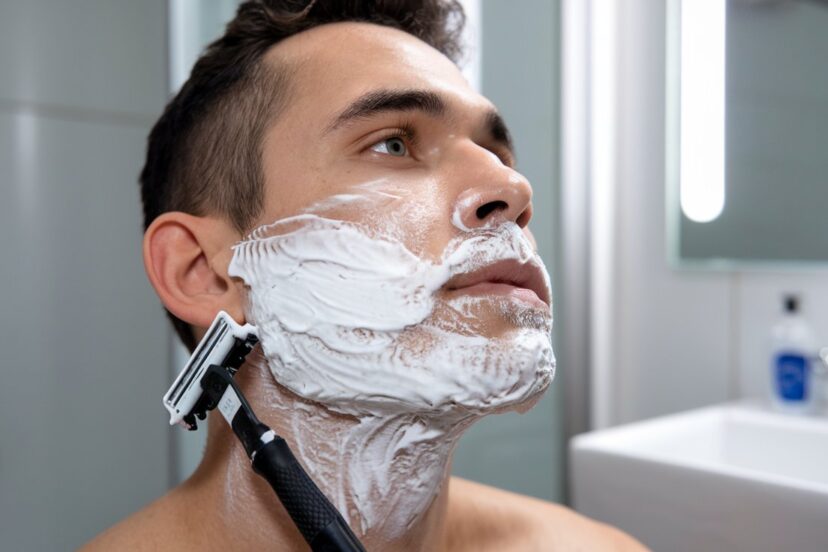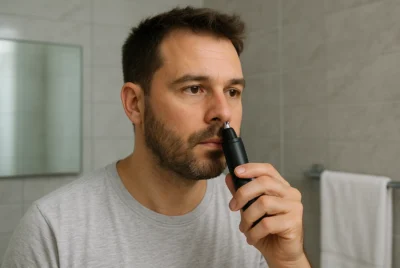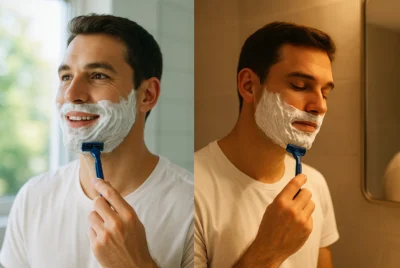How Does Shaving Cream Work: Benefits and Best Practices
Post Disclaimer
*We may earn a commission for purchases made using our links. Please see our disclosure to learn more.
Shaving can often leave your skin feeling irritated and dry. Interestingly, the right shaving cream can change that experience completely. This article will guide you through for how does shaving cream work and share best practices for application to ensure a smooth, moisturizing shave every time.
Keep reading for smoother skin!
What is Shaving Cream?
Shaving cream is a specialized product designed to lubricate and moisturize the skin, providing protection while softening facial hair for a smoother shave. Its formulation helps the razor glide effortlessly across the skin, reducing irritation and hydrating it in the process.
Ingredients
Shaving cream plays a crucial role in achieving a smooth, irritation-free shave. Its ingredients are specifically chosen to hydrate skin, protect against razor burn, and soften facial hair for an effortless glide.
- Water: Acts as the base of most shaving creams, ensuring they spread easily across your skin for proper coverage.
- Stearic Acid: This fatty acid helps to cleanse the skin and remove dirt, oil, and sweat from the hair follicles, making the beard hairs easier to cut.
- Glycerin: A humectant that attracts moisture to the skin, keeping it hydrated and reducing the risk of razor burn.
- Potassium Hydroxide: Works alongside stearic acid to turn those tough beard hairs softer, allowing for a closer shave without irritating sensitive skin.
- Coconut Acid: Derived from coconut oil, this ingredient contributes to the creamy texture of shaving cream while offering additional moisturizing properties.
- Fragrance: Added for a pleasant scent during the shaving process; however, unscented options are available for those with sensitive skin or allergies.
- Aloe Vera: Known for its soothing properties, aloe vera helps calm the skin and can prevent razor burn and ingrown hairs by moisturizing deeply.
- Vitamin E: An antioxidant that protects the skin from environmental damage while also conditioning the hair for easier cutting.
- Tea Tree Oil: Offers antiseptic properties that can help reduce acne breakouts and soothe irritated skin after shaving.
- Lanolin: A natural emollient that softens the skin and hair, making it less prone to nicks and cuts during shaving.
Each ingredient in shaving cream has a specific purpose aimed at improving your shaving experience by providing razor protection, hydrating ingredients for smooth skin, and reducing irritation for all users regardless of beard or sensitive skin types.
Purpose
Shaving cream serves multiple essential purposes when it comes to your shaving routine. It hydrates the skin, facilitating a smoother and closer shave by softening facial hair for effortless gliding of the razor.
Additionally, it provides a protective layer that reduces the risk of skin irritation caused by the shaving process, making it an indispensable product in your grooming arsenal.
The purpose of using shaving cream is not only limited to lubricating the skin but also extends to moisturization and protection from potential nicks and cuts during shaving. Its role in softening facial hair allows for precise and comfortable hair removal, especially when using sharp blades.
Overall, incorporating shaving cream into your daily grooming routine can significantly improve your shaving experience while keeping your skin hydrated and protected.
Moving on to Benefits…
Benefits of Using Shaving Cream
Using shaving cream provides lubrication for the razor, moisturizes the skin, and offers protection from irritation. It also softens facial hair for a smoother shave.
Lubrication
Shaving cream provides crucial lubrication for your skin, allowing the razor to glide smoothly and reducing the risk of nicks and cuts. Ensuring proper lubrication is essential in achieving a comfortable and effective shaving experience.
The shaving cream creates a protective layer between the blade and your skin, promoting a gentle shave without irritation. Additionally, it helps soften the hair for easy removal while hydrating the skin, leaving it feeling smooth and moisturized.
The lubricating properties of shaving cream are fundamental as they enable a seamless gliding motion when you shave, offering protection against potential irritation while keeping your skin nourished and hydrated.
Moisturization
Shaving cream provides more than just a smooth shave. It also offers essential moisturization to your skin, preventing dryness and irritation. The hydrating properties of shaving cream help in maintaining the natural moisture balance of your skin, leaving it soft and supple after each shave.
The moisturizing effect of shaving cream creates a barrier between the razor and your skin, reducing friction and minimizing the risk of nicks or cuts. For individuals with sensitive skin, this added layer of moisture can make a significant difference in comfort and overall skin health.
By incorporating a high-quality shaving cream into your routine, you can enjoy hydrated and nourished skin with every shave.
Protection
Shaving cream offers protection against skin irritation and razor burn, creating a barrier between the razor and your skin. This helps to minimize nicks and cuts while ensuring a smooth shaving experience.
By hydrating the skin, shaving cream also provides a layer of moisture that helps prevent dryness and soothes any potential post-shave discomfort.
The protective properties of shaving cream are particularly beneficial for individuals with sensitive skin or those prone to irritation. It acts as a shield, reducing friction and allowing the razor to glide effortlessly across the skin.
This not only protects from potential damage but also promotes an overall more comfortable shaving process.
In addition to protecting the skin during shaving, quality shaving creams also support its recovery after the shave is complete, leaving you feeling refreshed and safeguarded against any adverse effects.
Softening
To achieve a smoother shave, softening your facial hair is crucial. Shaving cream helps to soften the hair by hydrating and conditioning it, making it easier for the razor to glide through.
This process not only reduces tugging and pulling but also minimizes irritation, leaving your skin feeling smooth and comfortable after shaving.
By infusing moisture into the hair follicles, shaving cream primes your facial hair for a more efficient trimming experience. The softened hairs are more pliable, allowing for a closer shave without causing discomfort or redness.
Incorporating this step into your shaving routine can make a noticeable difference in how easily your razor glides across your skin while minimizing potential discomfort and irritation.
Best Practices for Using Shaving Cream
To get the most out of your shaving cream, it’s important to apply it properly and choose the right product for your skin type. Read on to discover the best practices for achieving a smooth and comfortable shave.
How to Apply Shaving Cream
To apply shaving cream effectively, prep your skin by washing your face with warm water to soften the hair and open the pores. Then, follow these steps:
- Squeeze a small amount of shaving cream into your hand and gently massage it onto your moistened skin.
- Use a shaving brush to lather the cream in circular motions, ensuring even coverage and lifting the hairs for a closer shave.
- Allow the cream to sit for a minute or two to further soften the hair and hydrate the skin.
- Proceed to shave with a sharp razor in the direction of hair growth for minimal irritation.
- Rinse your face thoroughly with cold water to close the pores and soothe any mild irritation.
Applying shaving cream ensures a smooth and comfortable shaving experience while protecting your skin from irritation and dehydration.
Choosing the Right Shaving Cream
When choosing the right shaving cream, consider your skin type and any specific concerns, such as sensitivity or dryness. Look for products with hydrating ingredients like aloe vera or glycerin to ensure your skin stays moisturized throughout the shaving process. Here are some considerations when choosing the right shaving cream:
- Skin Type: Determine if your skin is oily, dry, sensitive, or normal to select a shaving cream that caters to your specific needs.
- Ingredients: Check for natural and soothing ingredients like tea tree oil, shea butter, and coconut oil to minimize irritation and hydrate your skin.
- Scent: Choose a scent that aligns with your preferences but also consider fragrance-free options if you have sensitive skin.
- Texture: Opt for a rich and creamy texture for better lubrication and protection during shaving.
- Budget-Friendly Options: Explore different price points to find a quality shaving cream that suits your budget without compromising on performance.
- Compatibility: Ensure compatibility with other grooming products such as pre-shave oils or aftershave balms for a seamless grooming routine.
- Brand Reputation: Research trusted brands known for producing effective and gentle shaving creams to achieve optimal results.
- Environmental Impact: Consider eco-friendly options that prioritize sustainability by using recyclable packaging and natural ingredients.
Remember that selecting the right shaving cream can enhance your overall grooming experience while promoting healthier-looking skin.
Adding Pre/Post-Shave Products
To enhance your shaving experience, consider incorporating pre and post-shave products into your routine. This can help you achieve a smoother, more comfortable shave while promoting healthier skin. Here are some products to consider:
- Pre-Shave Oil: Applying pre-shave oil before shaving cream can help soften facial hair and provide an extra layer of protection against razor irritation.
- Exfoliating Scrub: Including an exfoliating scrub in your routine can help remove dead skin cells, reducing the likelihood of ingrown hairs and achieving a closer shave.
- Aftershave Lotion or Balm: Using aftershave lotion or balm after shaving can soothe the skin, reduce redness, and hydrate the skin to prevent dryness and irritation.
- Hydrating Moisturizer: Following up with a hydrating moisturizer after shaving helps replenish moisture lost during the process and keeps the skin smooth and supple.
By incorporating these pre and post-shave products into your grooming regimen, you can elevate your shaving experience while nurturing your skin for optimal results.
Conclusion
Shaving cream works by lubricating, moisturizing, and protecting the skin while softening facial hair. When applied properly, it allows the razor to glide smoothly, hydrates the skin, and guards against irritation.
Choosing the right shaving cream and including pre/post-shave products can enhance the overall experience. Therefore, understanding how shaving cream works and following best practices leads to a comfortable and effective shave.
FAQs
1. What does shaving cream do for your skin?
Shaving cream softens facial hair, hydrates the skin, and helps protect against irritation while you shave. It makes the razor glide smoothly over your face.
2. How should I apply shaving cream?
First, wet your skin with warm water to soften the hair. Then apply a layer of shaving foam or gel evenly across the area you plan to shave.
3. Can using shaving cream benefit my skin in other ways?
Yes! Besides making shaving easier, it also moisturizes your skin and can help exfoliate by removing dead skin cells when you shave.
4. Is there a difference between shaving foam and shaving gel?
Both are designed to prepare your skin for a smoother shave, but gels usually provide a thicker barrier which might offer better protection for sensitive skin types.
5. Should I use anything before applying shaving cream?
Using preshave oil before applying your foam or gel can further soften facial hair and enhance razor glide for an even closer, more comfortable shave.




